Vygotsky's Theory of Cognitive Development: ZPD and Scaffolding Explained
Understand Vygotsky's sociocultural theory, the Zone of Proximal Development (ZPD), and scaffolding. Learn how to apply Vygotsky's ideas in your classroom.


Understand Vygotsky's sociocultural theory, the Zone of Proximal Development (ZPD), and scaffolding. Learn how to apply Vygotsky's ideas in your classroom.
Lev Vygotsky’s theory emphasizes the vital role of culture, social interaction, and language in shaping a child’s cognitive development. Rather than viewing learning as an isolated process, Vygotsky argued that cognitive abilities, such as reasoning and communication, emerge through meaningful engagement in a socially and culturally enriched environment. His work underscores the significance of scaffolding strategies, where adults and peers provide support to guide children through tasks just beyond their current capabilities.
Although some aspects of stage-based theories have been questioned in contemporary research, Vygotsky’s concepts, such as the zone of proximal development, remain foundational. He proposed that development unfolds in stages that integrate cognitive, motoric, and sociocultural learning processes. These stages are not rigid or linear but are shaped by individual children’s interactions within complex learning environments. Cognitive learning involves thinking and problem-solving, motoric learning emphasizes physical engagement with tasks, and sociocultural learning highlights collaboration and shared meaning-making.
Language plays a central role in Vygotsky’s theory, serving as both a tool for thought and a means of communication. He introduced the concept of private speech, where children talk to themselves to process ideas and plan actions—a practice that evolves into internal thought. This use of language bridges personal understanding and external social contexts, enabling children to navigate increasingly challenging learning experiences.
Vygotsky also highlighted the importance of play as a cornerstone of development. Through imaginative activities, children experiment with roles, explore ideas, and build the foundations for higher-order thinking. For example, a child playing with blocks learns to manipulate objects physically, develops an understanding of spatial relationships, and eventually grasps abstract concepts such as gravity or balance—all within a socially interactive and supportive framework.
This article will delve deeper into Vygotsky’s contributions to psychology, exploring their relevance in contemporary education and how they can inform effective teaching practices. By examining his theories in detail, we aim to provide actionable insights for fostering learning and development in diverse contexts.
Lev Semenovich Vygotsky (1896–1934) laid the foundation for what we now call sociocultural theory. Unlike contemporaries such as Gesell and Piaget—who emphasised biological maturation and independent discovery—Vygotsky placed culture and social interaction at the heart of cognitive development. He believed that while children are active participants in their growth, their highest forms of thinking originate from external, culturally mediated experiences.
According to Vygotsky, learning does not happen in isolation. He argued that language, writing, and symbolic systems inherited through culture are essential tools that shape thought. A key element of his theory is that children develop through social interactions with more knowledgeable others, such as parents, teachers, or peers. These interactions help them internalise complex ideas, gradually moving from shared understanding to independent thought.
Vygotsky observed that children first engage with the world through imitation. Over time, these actions are internalised, forming the basis for higher mental functions like reasoning and self-regulation. He called this process internalization, through which external guidance becomes part of a child's independent thinking. This concept is central to understanding how knowledge and skills are transferred through dialogue and shared activity.
Language plays a critical role in this process. Vygotsky believed that thought is shaped by speech, and that talking with others supports problem-solving, reflection, and learning. He also championed the idea that teaching should be responsive, adapting to the learner's developmental stage—a principle that resonates with today's personalised learning approaches.
Though not without criticism, Vygotsky’s work continues to influence classrooms worldwide, especially in areas like scaffolding, oracy, and formative assessment.
Key Takeaways from Vygotsky’s Background:
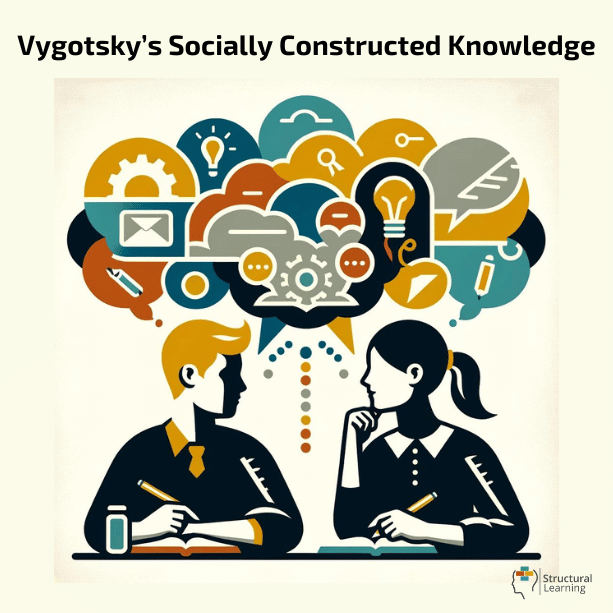
This process of imitation and observation is called internalization. Internalization allows us to transfer knowledge from one person to another. For example, if you teach someone how to play tennis, you can expect him or her to eventually become a tennis player. Vygotsky also believed that the way in which we communicate with others influences the way in which we learn. According to him, we learn by talking to others and listening to what they say. We then try to apply what we learned to similar situations in the future.
In addition to studying children, Vygotsky also spent much of his career working with teachers. His goal was to develop ways in which teachers could enhance students' abilities to learn. One of his ideas was that teaching methods must be adapted to fit the individual student. His theories have influenced educational practices worldwide. However, his ideas have also been criticized. Some argue that Vygotsky's emphasis on interaction between teacher and learner is too simplistic. Others believe that his focus on external factors rather than internal ones is misguided.
Regardless of whether you agree with his theories, Vygotsky's influence cannot be denied. His ideas continue to shape education today.
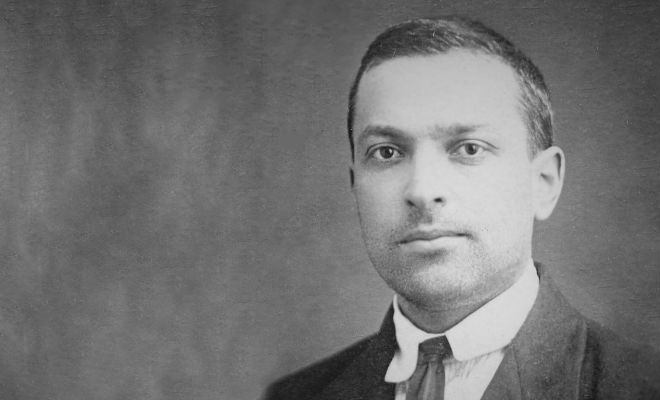
Zone of Proximal Development (ZPD) is the most famous mental development concept proposed by L.S. Vygotsky. According to this theory, ZPD indicates the wide variety of cognitive processes a child demonstrates under the supervision of an expert but is unable to perform on his own.
What are the stages of ZPD?
A learner may fall into one of the three distinct categories of mental functions, based on their skill set. For successful psychological functions and learning, the expert must know the specific state of a learner's mental functions.
Tasks a learner cannot perform in presence of assistance
Outside of a learner's ZPD, are the tasks that the learner's current ability does not allow him to complete, even in presence of an expert's help. According to Vygotsky theory of development here, the expert may decrease the level of difficulty and look for more appropriate tasks according to the mental development and skill level of the learner.
A learner is nearly mastering a skill set needed to complete a task, nevertheless, still needs the supervision of an expert. Vygotsky believes that here, an expert may apply different techniques to enable the learner better understand the skills and concepts needed to perform a task without assistance.
A learner has mastered the skill set needed to complete a task independently. The assistance of an expert is not needed. According to Vygotsky after reaching this stage, an expert may increase the individual level of task difficulty to find a child's next ZPD.

According to L.S. Vygotsky theory of development, when a learner is in their ZPD, an expert will provide appropriate assistance to the learner to help him accomplish a new skill or task. According to scaffolding theory, resources, tools, instructions, and activities, that are used to support the learning process are referred to as scaffolding.
Scaffolding refers to the structure provided by other learners while learning a skill. When someone learns a new skill, they usually follow a series of steps to master it. These steps are called "scaffolds," and they provide a foundation upon which the learner builds his or her skills.
When teaching students, teachers typically create scaffolds to guide them through each lesson. Scaffolds help students understand concepts and remember details, and they also allow teachers to focus on specific areas of instruction rather than having to cover every single topic.
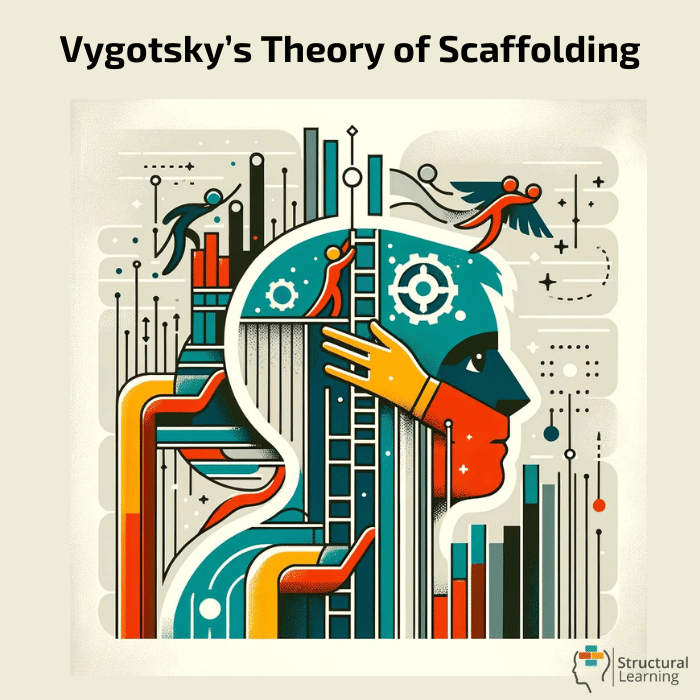
Following are the examples of scaffolding that instructors may use:
Ultimately, the learner can complete the entire task after the removal of the scaffolding.
Although, scaffolding is most frequently linked with the L. S. Vygotsky ZPD, it was not a concept initially proposed by the soviet psychologist. This term was introduced by other researchers in human development and mental functions who were in Vygotsky circle. They expanded on L.S. Vygotsky original theories of human development.
Scaffolding theory can be significantly useful to teach students a new skill or a mental development concept. However, if the teacher is unaware of the unique ZPD of each student, application of scaffolding theory may not be very effective.
While scaffolding is helpful for both teachers and learners, it can be difficult to implement effectively. Teachers who try to force students to memorize facts and procedures risk creating rote learners who lack creativity and critical thinking. At the same time, teachers who don't scaffold enough risk failing to teach students anything at all.
To avoid falling into either trap, teachers must strike a balance between giving students plenty of scaffolding and allowing them to develop creative solutions to problems. Fortunately, there are several ways to achieve this balance. For instance, teachers can give students practice exercises that require them to solve problems creatively. They can also ask questions that require students to explain their reasoning. Finally, they can model effective problem-solving techniques and then give students opportunities to apply them themselves.

In addition to helping teachers build stronger relationships with their students, scaffolding helps learners become independent thinkers. Because scaffolding provides a framework for learning, students can explore topics on their own terms. This allows them to gain confidence in their abilities and encourages them to seek out additional resources if necessary.
The following outlines some of the difficulties teachers may face while using scaffolding in the classroom.
Lev Vygotsky's sociocultural theory of language and thought development posits that social interaction plays a crucial role in intellectual development. In Vygotsky's view, mental functions are not innate, but instead are shaped and influenced by social and cultural contexts. The role of language is especially important, as it serves as a tool for thought and communication.
According to Vygotsky, language is not simply a means of expressing existing thoughts, but is necessary for the formation of cognitive processes. Vygotsky argues that language and thought are inextricably linked, with each influencing and shaping the other.
Vygotsky's theory emphasizes that intellectual development is a social process that occurs through interaction with others. Through this interaction, individuals engage in external speech, which enables them to organize their thoughts and regulate their behavior.
Additionally, Vygotsky contends that intellectual adaptation occurs when individuals move from their current level of development to a higher level. The transitions between these levels are facilitated through social interactions with individuals who possess a greater degree of knowledge and experience.
Overall, Vygotsky's sociocultural theory of language and thought development highlights the importance of social interaction in cognitive development, emphasizing that the relationships individuals form with others and the cultural and societal contexts in which they exist are fundamental determinants of intellectual growth.
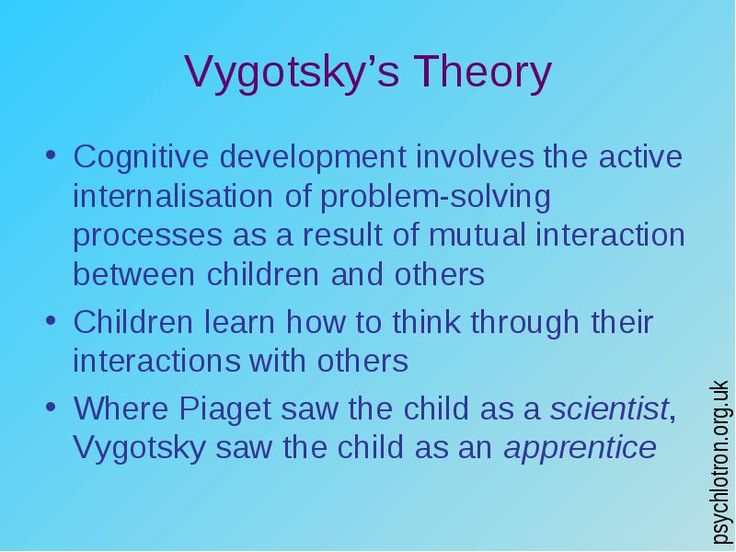
According to psychology of emotions and social speech, people talk to themselves internally. In most cases, they talk to themselves when they are struggling with something wrong or when they feel emotional or trying to recall something. The same goes for the process of development in children. This was interpreted by Piaget as Egocentric Speech.
Egocentric Speech occurs due to a child's inability to perceive things from another's viewpoint. But, the developmental psychology expert Vygotsky believed that in egocentric speech, children talk to themselves to clarify thoughts or to show problem-solving skills. According to Social Development Theory when children are learning to use words while they are thinking, they tend to do so in a loud voice before finally engaging in inner speech or Private Speech while their lips are closed.
Thinking with a loud voice finally becomes thought alongside internal speech, and people start to talk to themselves only while trying to remember something or learn something. Vygotsky believes that the inner speech of people is opposite to external speech. Internal speech is not as detailed as the external speech that one uses to communicate with others.
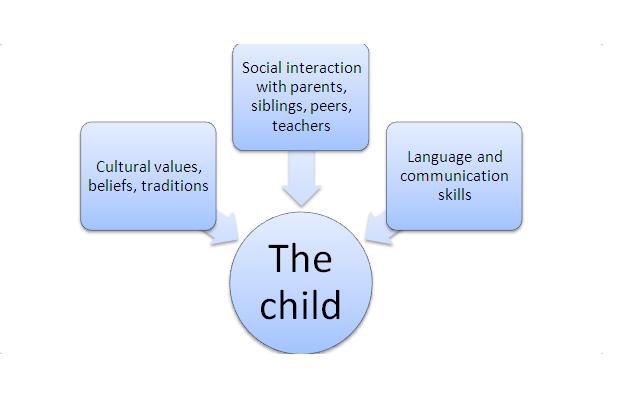
According to Piaget's cognitive development theory, when teachers take control of the learning process in children it puts the individual development of children in a passive position. According to developmental psychology, teachers may explain abstract ideas without actual understanding of the child's developmental level, and instead, children just repeat back whatever they hear. According to Piaget's Cognitive Development Theory, children must be provided with opportunities for psychological development and exploring concepts of independent learning.
On the other hand, according to Vygotsky's Cognitive Theory, children can reach a superior cognitive developmental level of language acquisition even in absence of teachings, taught by more learned people. Both, developmental psychologists Piaget's and Vygotsky 's theories considerably contribute to people's understanding of how children learn and perform cognitive functions.
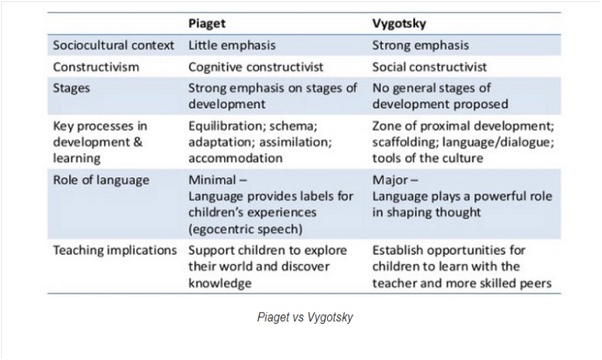
According to Vygotsky's theory of development, social interaction between a learner and someone more knowledgeable is a must for successful social learning and social development. The more knowledgeable individual can be an adult or a more knowledgeable peer. According to Lev Vygotsky mental abilities theory, when children are learning a new concept it is crucial to have an adult as an instructor. However, if some learners grasp the topic, while other learners are still in their ZPD, peer interaction may develop the most effective cognitive awareness environment for students psychological development, cognitive functions and learning process.
Lev Vygotsky's theory of development and concept of zones of proximal development is considered his most crucial contribution to formal degree education. This is a useful concept because teachers may use it to assess a child's developmental progress. An effective teacher recognizes a child’s ZPD and supports the child to stretch beyond it. Afterwards, the teacher slowly withdraws support when the child can perform the task through independent learning. Scaffolding technique can be considered as the temporary support that teachers or parents may use to help a child do a task.

As we have seen, Lev Vygotsky, revolutionized education through his sociocultural theory, emphasizing the crucial role of social interaction and cultural contexts in cognitive growth. The principles of peer collaboration, private speech, and the zone of proximal development (ZPD) have become foundational in classroom practices. Below is a table summarizing key studies that evaluate the efficacy of adopting Vygotsky’s principles in educational settings.
| Key Study | Key Outcomes | Strength of Evidence | Additional Notes |
|---|---|---|---|
| Tudge (1992) | Peer collaboration within the ZPD enhances problem-solving and mathematical reasoning in children. | Strong: Empirical studies in classroom settings. | Highlights the role of a skilled partner in supporting cognitive processes. |
| Marginson & Dang (2017) | Globalized educational practices can adapt Vygotsky’s sociocultural approach to foster dynamic learning. | Moderate: Theoretical synthesis with practical implications. | Suggests modifications for contemporary cultural contexts. |
| Helou & Newsome (2018) | Peer and experiential learning based on Vygotsky’s framework improve cognitive development and retention. | Strong: Mixed-method research with actionable findings. | Reinforces the cultural and social underpinnings of mental processes. |
| Winsler (2003) | Application of Cultural Historical Activity Theory (CHAT) improves early childhood educational outcomes. | Moderate: Focus on semiotic mediation and private speech. | Examines translation of theoretical concepts into practical teaching strategies. |
| Haenen (2001) | Expands ZPD by integrating step-by-step teaching models to support internalization of mental actions. | Strong: Applied research in developmental psychology. | Outlines the formative role of structured scaffolding in student progress. |
These studies collectively underscore the transformative potential of Vygotsky’s sociocultural approach in education. By emphasizing peer interactions, private speech, and scaffolded learning, these principles enable students to transition from assisted to independent problem-solving, fostering both immediate and long-term cognitive growth. The sociocultural perspective continues to shape educational strategies, highlighting the interplay between culture, social context, and learning processes.

These papers collectively highlight the profound impact of Lev Vygotsky's theories on understanding cognitive growth, child development, and the implementation of active and cooperative learning techniques within educational contexts.
Lev Vygotsky’s theory emphasizes the vital role of culture, social interaction, and language in shaping a child’s cognitive development. Rather than viewing learning as an isolated process, Vygotsky argued that cognitive abilities, such as reasoning and communication, emerge through meaningful engagement in a socially and culturally enriched environment. His work underscores the significance of scaffolding strategies, where adults and peers provide support to guide children through tasks just beyond their current capabilities.
Although some aspects of stage-based theories have been questioned in contemporary research, Vygotsky’s concepts, such as the zone of proximal development, remain foundational. He proposed that development unfolds in stages that integrate cognitive, motoric, and sociocultural learning processes. These stages are not rigid or linear but are shaped by individual children’s interactions within complex learning environments. Cognitive learning involves thinking and problem-solving, motoric learning emphasizes physical engagement with tasks, and sociocultural learning highlights collaboration and shared meaning-making.
Language plays a central role in Vygotsky’s theory, serving as both a tool for thought and a means of communication. He introduced the concept of private speech, where children talk to themselves to process ideas and plan actions—a practice that evolves into internal thought. This use of language bridges personal understanding and external social contexts, enabling children to navigate increasingly challenging learning experiences.
Vygotsky also highlighted the importance of play as a cornerstone of development. Through imaginative activities, children experiment with roles, explore ideas, and build the foundations for higher-order thinking. For example, a child playing with blocks learns to manipulate objects physically, develops an understanding of spatial relationships, and eventually grasps abstract concepts such as gravity or balance—all within a socially interactive and supportive framework.
This article will delve deeper into Vygotsky’s contributions to psychology, exploring their relevance in contemporary education and how they can inform effective teaching practices. By examining his theories in detail, we aim to provide actionable insights for fostering learning and development in diverse contexts.
Lev Semenovich Vygotsky (1896–1934) laid the foundation for what we now call sociocultural theory. Unlike contemporaries such as Gesell and Piaget—who emphasised biological maturation and independent discovery—Vygotsky placed culture and social interaction at the heart of cognitive development. He believed that while children are active participants in their growth, their highest forms of thinking originate from external, culturally mediated experiences.
According to Vygotsky, learning does not happen in isolation. He argued that language, writing, and symbolic systems inherited through culture are essential tools that shape thought. A key element of his theory is that children develop through social interactions with more knowledgeable others, such as parents, teachers, or peers. These interactions help them internalise complex ideas, gradually moving from shared understanding to independent thought.
Vygotsky observed that children first engage with the world through imitation. Over time, these actions are internalised, forming the basis for higher mental functions like reasoning and self-regulation. He called this process internalization, through which external guidance becomes part of a child's independent thinking. This concept is central to understanding how knowledge and skills are transferred through dialogue and shared activity.
Language plays a critical role in this process. Vygotsky believed that thought is shaped by speech, and that talking with others supports problem-solving, reflection, and learning. He also championed the idea that teaching should be responsive, adapting to the learner's developmental stage—a principle that resonates with today's personalised learning approaches.
Though not without criticism, Vygotsky’s work continues to influence classrooms worldwide, especially in areas like scaffolding, oracy, and formative assessment.
Key Takeaways from Vygotsky’s Background:

This process of imitation and observation is called internalization. Internalization allows us to transfer knowledge from one person to another. For example, if you teach someone how to play tennis, you can expect him or her to eventually become a tennis player. Vygotsky also believed that the way in which we communicate with others influences the way in which we learn. According to him, we learn by talking to others and listening to what they say. We then try to apply what we learned to similar situations in the future.
In addition to studying children, Vygotsky also spent much of his career working with teachers. His goal was to develop ways in which teachers could enhance students' abilities to learn. One of his ideas was that teaching methods must be adapted to fit the individual student. His theories have influenced educational practices worldwide. However, his ideas have also been criticized. Some argue that Vygotsky's emphasis on interaction between teacher and learner is too simplistic. Others believe that his focus on external factors rather than internal ones is misguided.
Regardless of whether you agree with his theories, Vygotsky's influence cannot be denied. His ideas continue to shape education today.

Zone of Proximal Development (ZPD) is the most famous mental development concept proposed by L.S. Vygotsky. According to this theory, ZPD indicates the wide variety of cognitive processes a child demonstrates under the supervision of an expert but is unable to perform on his own.
What are the stages of ZPD?
A learner may fall into one of the three distinct categories of mental functions, based on their skill set. For successful psychological functions and learning, the expert must know the specific state of a learner's mental functions.
Tasks a learner cannot perform in presence of assistance
Outside of a learner's ZPD, are the tasks that the learner's current ability does not allow him to complete, even in presence of an expert's help. According to Vygotsky theory of development here, the expert may decrease the level of difficulty and look for more appropriate tasks according to the mental development and skill level of the learner.
A learner is nearly mastering a skill set needed to complete a task, nevertheless, still needs the supervision of an expert. Vygotsky believes that here, an expert may apply different techniques to enable the learner better understand the skills and concepts needed to perform a task without assistance.
A learner has mastered the skill set needed to complete a task independently. The assistance of an expert is not needed. According to Vygotsky after reaching this stage, an expert may increase the individual level of task difficulty to find a child's next ZPD.

According to L.S. Vygotsky theory of development, when a learner is in their ZPD, an expert will provide appropriate assistance to the learner to help him accomplish a new skill or task. According to scaffolding theory, resources, tools, instructions, and activities, that are used to support the learning process are referred to as scaffolding.
Scaffolding refers to the structure provided by other learners while learning a skill. When someone learns a new skill, they usually follow a series of steps to master it. These steps are called "scaffolds," and they provide a foundation upon which the learner builds his or her skills.
When teaching students, teachers typically create scaffolds to guide them through each lesson. Scaffolds help students understand concepts and remember details, and they also allow teachers to focus on specific areas of instruction rather than having to cover every single topic.

Following are the examples of scaffolding that instructors may use:
Ultimately, the learner can complete the entire task after the removal of the scaffolding.
Although, scaffolding is most frequently linked with the L. S. Vygotsky ZPD, it was not a concept initially proposed by the soviet psychologist. This term was introduced by other researchers in human development and mental functions who were in Vygotsky circle. They expanded on L.S. Vygotsky original theories of human development.
Scaffolding theory can be significantly useful to teach students a new skill or a mental development concept. However, if the teacher is unaware of the unique ZPD of each student, application of scaffolding theory may not be very effective.
While scaffolding is helpful for both teachers and learners, it can be difficult to implement effectively. Teachers who try to force students to memorize facts and procedures risk creating rote learners who lack creativity and critical thinking. At the same time, teachers who don't scaffold enough risk failing to teach students anything at all.
To avoid falling into either trap, teachers must strike a balance between giving students plenty of scaffolding and allowing them to develop creative solutions to problems. Fortunately, there are several ways to achieve this balance. For instance, teachers can give students practice exercises that require them to solve problems creatively. They can also ask questions that require students to explain their reasoning. Finally, they can model effective problem-solving techniques and then give students opportunities to apply them themselves.

In addition to helping teachers build stronger relationships with their students, scaffolding helps learners become independent thinkers. Because scaffolding provides a framework for learning, students can explore topics on their own terms. This allows them to gain confidence in their abilities and encourages them to seek out additional resources if necessary.
The following outlines some of the difficulties teachers may face while using scaffolding in the classroom.
Lev Vygotsky's sociocultural theory of language and thought development posits that social interaction plays a crucial role in intellectual development. In Vygotsky's view, mental functions are not innate, but instead are shaped and influenced by social and cultural contexts. The role of language is especially important, as it serves as a tool for thought and communication.
According to Vygotsky, language is not simply a means of expressing existing thoughts, but is necessary for the formation of cognitive processes. Vygotsky argues that language and thought are inextricably linked, with each influencing and shaping the other.
Vygotsky's theory emphasizes that intellectual development is a social process that occurs through interaction with others. Through this interaction, individuals engage in external speech, which enables them to organize their thoughts and regulate their behavior.
Additionally, Vygotsky contends that intellectual adaptation occurs when individuals move from their current level of development to a higher level. The transitions between these levels are facilitated through social interactions with individuals who possess a greater degree of knowledge and experience.
Overall, Vygotsky's sociocultural theory of language and thought development highlights the importance of social interaction in cognitive development, emphasizing that the relationships individuals form with others and the cultural and societal contexts in which they exist are fundamental determinants of intellectual growth.

According to psychology of emotions and social speech, people talk to themselves internally. In most cases, they talk to themselves when they are struggling with something wrong or when they feel emotional or trying to recall something. The same goes for the process of development in children. This was interpreted by Piaget as Egocentric Speech.
Egocentric Speech occurs due to a child's inability to perceive things from another's viewpoint. But, the developmental psychology expert Vygotsky believed that in egocentric speech, children talk to themselves to clarify thoughts or to show problem-solving skills. According to Social Development Theory when children are learning to use words while they are thinking, they tend to do so in a loud voice before finally engaging in inner speech or Private Speech while their lips are closed.
Thinking with a loud voice finally becomes thought alongside internal speech, and people start to talk to themselves only while trying to remember something or learn something. Vygotsky believes that the inner speech of people is opposite to external speech. Internal speech is not as detailed as the external speech that one uses to communicate with others.

According to Piaget's cognitive development theory, when teachers take control of the learning process in children it puts the individual development of children in a passive position. According to developmental psychology, teachers may explain abstract ideas without actual understanding of the child's developmental level, and instead, children just repeat back whatever they hear. According to Piaget's Cognitive Development Theory, children must be provided with opportunities for psychological development and exploring concepts of independent learning.
On the other hand, according to Vygotsky's Cognitive Theory, children can reach a superior cognitive developmental level of language acquisition even in absence of teachings, taught by more learned people. Both, developmental psychologists Piaget's and Vygotsky 's theories considerably contribute to people's understanding of how children learn and perform cognitive functions.

According to Vygotsky's theory of development, social interaction between a learner and someone more knowledgeable is a must for successful social learning and social development. The more knowledgeable individual can be an adult or a more knowledgeable peer. According to Lev Vygotsky mental abilities theory, when children are learning a new concept it is crucial to have an adult as an instructor. However, if some learners grasp the topic, while other learners are still in their ZPD, peer interaction may develop the most effective cognitive awareness environment for students psychological development, cognitive functions and learning process.
Lev Vygotsky's theory of development and concept of zones of proximal development is considered his most crucial contribution to formal degree education. This is a useful concept because teachers may use it to assess a child's developmental progress. An effective teacher recognizes a child’s ZPD and supports the child to stretch beyond it. Afterwards, the teacher slowly withdraws support when the child can perform the task through independent learning. Scaffolding technique can be considered as the temporary support that teachers or parents may use to help a child do a task.

As we have seen, Lev Vygotsky, revolutionized education through his sociocultural theory, emphasizing the crucial role of social interaction and cultural contexts in cognitive growth. The principles of peer collaboration, private speech, and the zone of proximal development (ZPD) have become foundational in classroom practices. Below is a table summarizing key studies that evaluate the efficacy of adopting Vygotsky’s principles in educational settings.
| Key Study | Key Outcomes | Strength of Evidence | Additional Notes |
|---|---|---|---|
| Tudge (1992) | Peer collaboration within the ZPD enhances problem-solving and mathematical reasoning in children. | Strong: Empirical studies in classroom settings. | Highlights the role of a skilled partner in supporting cognitive processes. |
| Marginson & Dang (2017) | Globalized educational practices can adapt Vygotsky’s sociocultural approach to foster dynamic learning. | Moderate: Theoretical synthesis with practical implications. | Suggests modifications for contemporary cultural contexts. |
| Helou & Newsome (2018) | Peer and experiential learning based on Vygotsky’s framework improve cognitive development and retention. | Strong: Mixed-method research with actionable findings. | Reinforces the cultural and social underpinnings of mental processes. |
| Winsler (2003) | Application of Cultural Historical Activity Theory (CHAT) improves early childhood educational outcomes. | Moderate: Focus on semiotic mediation and private speech. | Examines translation of theoretical concepts into practical teaching strategies. |
| Haenen (2001) | Expands ZPD by integrating step-by-step teaching models to support internalization of mental actions. | Strong: Applied research in developmental psychology. | Outlines the formative role of structured scaffolding in student progress. |
These studies collectively underscore the transformative potential of Vygotsky’s sociocultural approach in education. By emphasizing peer interactions, private speech, and scaffolded learning, these principles enable students to transition from assisted to independent problem-solving, fostering both immediate and long-term cognitive growth. The sociocultural perspective continues to shape educational strategies, highlighting the interplay between culture, social context, and learning processes.

These papers collectively highlight the profound impact of Lev Vygotsky's theories on understanding cognitive growth, child development, and the implementation of active and cooperative learning techniques within educational contexts.